March 27, 2018

Ask any parent: You can’t get a bandage to stay put on a scraped knee or elbow. A couple of bends of the joint, and off it goes. Researchers at the Massachusetts Institute of Technology (MIT) say they have found a solution, and it’s inspired by kirigami, an origami-like exercise that involves cutting intricate patterns into a paper, which is then folded to create elaborate three-dimensional structures. By cutting kirigami-like slits into an elastomer film coated with an adhesive, the researchers were able to show that it could maintain its hold on deformable regions of the body, such as knees and elbows, even after 100 bending cycles, according to an article published today in MIT News.
|
Small kirigami-like slits in a polymer film enable the material to stick to the skin, even after 100 knee bends. The same film without slits debonds after just one bending cycle. Image courtesy MIT News. |
The “kirigami film” was attached to a volunteer’s knee. The researchers observed that each time she bent her knee, the film’s slits opened at the center, where the bending was most pronounced, while the slits at the edges remained closed, allowing the film to remain bonded to the skin, writes Jennifer Chu in MIT News. The kirigami structure gave the film not only stretchability, but also improved its grip: The cuts that open release tension that would otherwise cause the entire film to peel away from the skin.
To demonstrate potential applications, the group fabricated a kirigami-patterned adhesive bandage, as well as a heat pad consisting of a kirigami film threaded with heating wires. With the application of a 3-volt power supply, the pad maintains a steady temperature of 100°F. The group has also engineered a wearable electronic film outfitted with light-emitting diodes. All three films can function and stick to the skin, even after 100 knee bends, writes Chu. The researchers also envision applications in the wearables sector.
“Currently in the soft electronics field, people mostly attach devices to regions with small deformations, but not in areas with large deformations such as joint regions, because they would detach,” said Ruike Zhao, a postdoc in MIT’s Department of Mechanical Engineering. “I think kirigami film is one solution to this problem commonly found in adhesives and soft electronics.”
Ruike is the lead author of a paper published online this month in the journal Soft Matter. Her co-authors are graduate students Shaoting Lin and Hyunwoo Yuk, along with Xuanhe Zhao, the Noyce Career Development Professor in MIT’s Department of Mechanical Engineering.
Scientists have been exploring kirigami as a way to develop new, functional materials, but, Ruike told MIT News, her group is “the first to find, with a systematic mechanism study, that a kirigami design can improve a material’s adhesion.”
To determine why kirigami cuts enhance a material’s adhesive properties, the researchers first bonded a kirigami film to a polymer surface, then subjected the material to stretch tests. They measured the amount of stretch a kirigami film can undergo before peeling away from the polymer surface—a measurement they used to calculate the material’s critical “energy-release rate,” a quantity to evaluate detaching, reports MIT News.
They found that this energy-release rate varied throughout a single film: When they pulled the film from either end like an accordion, the slits toward the middle exhibited a higher energy-release rate and were first to peel open under less stretch. By contrast, the slits at either end of the film continued to stick to the underlying surface and remained closed.
Through these experiments, Ruike identified three main parameters that give kirigami films their adhesive properties: Shear-lag, in which shear deformation of film can reduce the strain on other parts of the film; partial debonding, in which the film segments around an open slit maintain a partial bond to the underlying surface; and in-homogenous deformation, in which a film can maintain its overall adhesion, even as parts of its underlying surface may bend and stretch more than others.
Depending on the application, Ruike says researchers can use the team’s findings as a design blueprint to identify the best pattern of cuts and the optimal balance of the three parameters for a given application.
“These three parameters will help guide the design of soft, advanced materials,” Ruike says. “You can always design other patterns, just like folk art. There are so many solutions that we can think of. Just follow the mechanical guidance for an optimized design, and you can achieve a lot of things.”
About the Author(s)
You May Also Like



